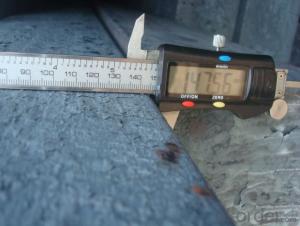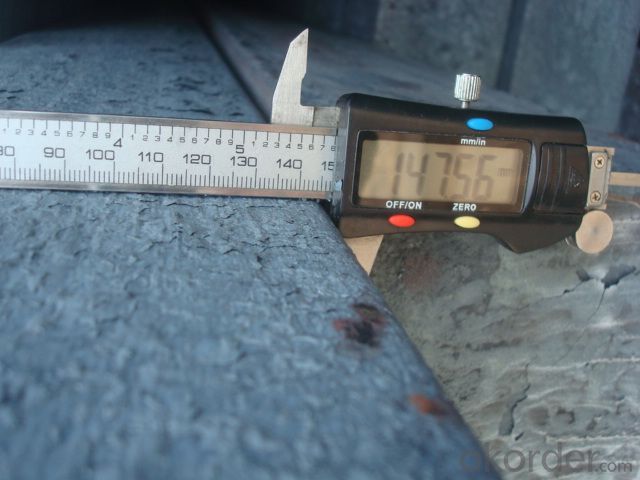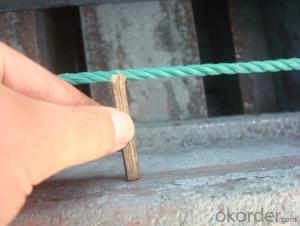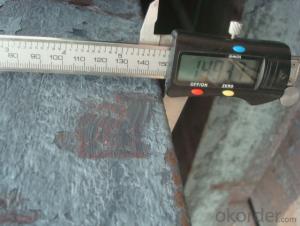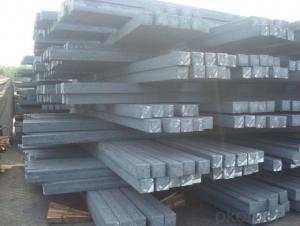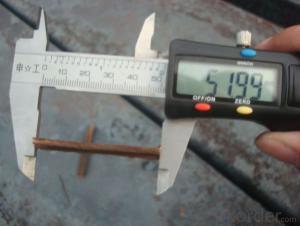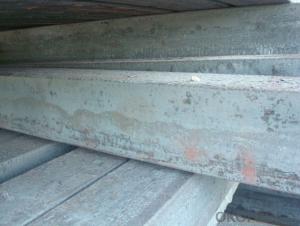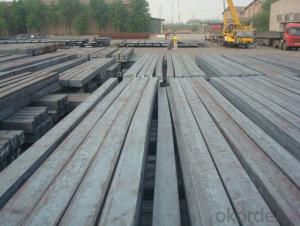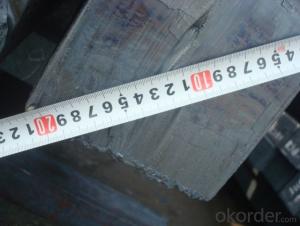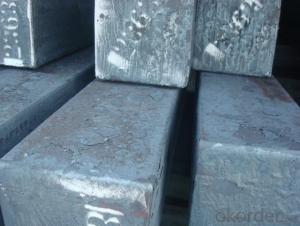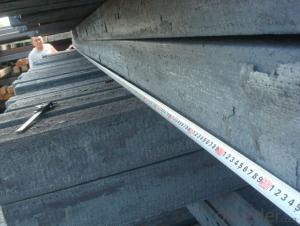Continue Casting Steel Billet Manufactured By Blasting Furnace
- Loading Port:
- Qingdao
- Payment Terms:
- TT OR LC
- Min Order Qty:
- 1000 m.t.
- Supply Capability:
- 10000 m.t./month
OKorder Service Pledge
OKorder Financial Service
You Might Also Like
Continue Casting Steel Billet Manufactured By Blasting Furnace
1.Structure of Continue Casting Steel Billet Manufactured By Blasting Furnace
Continue Casting Steel Billet Manufactured By Blasting Furnace is the raw material of all kinds of steel mill. Billet section of square, round, flat, rectangular and abnormity, etc Several, mainly related to shape of rolled products. Simple rolled section steel, choose cross section of square billet or rectangular billet. rolling The sector products such as flat steel, Angle steel, select the rectangular billet or slab. Had better profiled billet when production beams, channels, and in rolling process Lines and improve the yield. The raw material of round billet is the production of seamless tube.
2.Main Features of Continue Casting Steel Billet Manufactured By Blasting Furnace.
Continue Casting Steel Billet Manufactured By Blasting Furnace section size should meet the requirements of rolling deformation and finished product quality, but also roll strength and biting condition of restrictions. General steel Billet section height H. And the roll diameter D The ratio of the ( namely H/D) Should be less than or equal to zero 0.5 . Length of steel billet by finishing temperature, Rolling time and the length of the product Or times ruler. When heated too long accident prone to bump the furnace wall of steel, too short, furnace bottom utilization rate is not high, influence the heating furnace production. For the production Choose a variety of steel and steel billet, should consider the affinities of billet, as far as possible in order to improve the productivity of the roughing mill, simplify the stock management of workshop.
3. Continue Casting Steel Billet Manufactured By Blasting Furnace Images
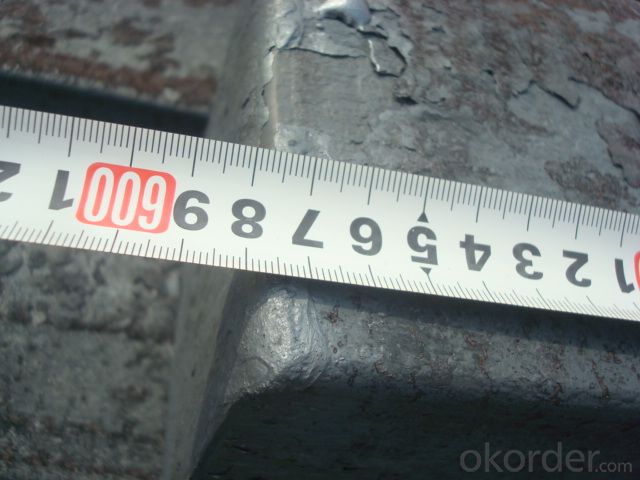
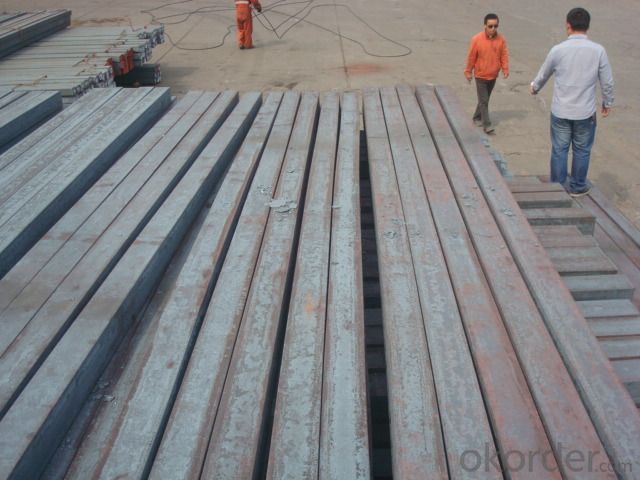
4. Continue Casting Steel Billet Manufactured By Blasting Furnace Specification
Continue Casting Steel Billet Manufactured By Blasting Furnace rolled steel, after processing can be used for mechanical parts, forging parts, processing all kinds of steel, steel Q345B channel steel, wire rod is the role of the billet. Steel billet is used in the production of semi-finished products, generally cannot be used directly for the society. Steel billets and steel are strictly divided into standard, cannot decide to whether the business enterprise of the final product, and according to unified standards to perform the whole society. Typically, billet and the steel is relatively easy to distinguish, but for some steel billet, and have the same specification and same steel purposes (such as rolling tube billet), whether can be used for other industries, whether through steel processing process, whether through a finished product rolling mill processing to distinguish
Material standard The editor Range of thickness: 150-240 - mm + / - 5 mm width range: 880-1530 - mm + / - 20 mm Length: 3700-10000 - mm + / - 500 - mm Cross-sectional size: 64 * 64; 82 * 82; 98 * 98; 124 * 124; 120 * 150; 152 * 164; 152 * 170 mm Length: 9000 mm Section of tolerance: billet: 1.0 + / - 2.0-1.0 + / - 1.0 mm slab: width: + / - 2.0 mm thickness: + / - 3.0 mm The length tolerance: + / - 200 mm Section diagonal tolerance: 3.5-8.0 MM Billet section size protrusions requirements: < 1242 mm, do not allow; > = 1242 mm, < = 2 mm 1242 mm, < = 3 mm Beheading (shear) extension deformation: < 1242 mm billet: no control; The slab: < = 15 mm Surface tilt: no more than billet section 0.1 Bending: every 1 m length is not more than 10 mm The distortion: length < = 5 m, < = 11. ; The length of the < = 7.5 M, < = 5. Material % 3 sp/PS chemical composition: C Mn Si S P
There are three shapes of the steel billets: square billet, slab, rectangular billet The Chinese billet, rectangular billet is mainly suitable for rolling hot rolled strip, building reinforced bar, Ordinary wire, high speed wire rod and various small profile. Of the slab are mainly used for rolling plate and hot coil sheet.
5.FAQ of Continue Casting Steel Billet Manufactured By Blasting Furnace
We have organized several common questions for our clients,may help you sincerely:
①How about your company?
A world class manufacturer & supplier of castings forging in carbon steel and alloy steel,is one of the large-scale professional investment casting production bases in China,consisting of both casting foundry forging and machining factory. Annually more than 8000 tons Precision casting and forging parts are exported to markets in Europe,America and Japan. OEM casting and forging service available according to customer’s requirements.
②How to guarantee the quality of the products?
We have established the international advanced quality management system,every link from raw material to final product we have strict quality test;We resolutely put an end to unqualified products flowing into the market. At the same time, we will provide necessary follow-up service assurance.
③How is the packaging and delivery?
Loose by Vessel and the delivery term is based on the the quantity and our factory’s schedule then.
- Q: How are steel billets transported and stored?
- In order to guarantee the quality and safety of steel billets, a careful and systematic approach is typically employed in their transportation and storage. In terms of transportation, trucks and railcars are commonly utilized for moving steel billets. Trucks are frequently used for short distances within a steel mill or between different facilities, while railcars are preferred for longer distances, including intercity or even international transport. To load the steel billets onto trucks or railcars, cranes or forklifts are utilized. It is of utmost importance to properly secure the billets to prevent any movement or damage during transit. Straps, chains, or other securing methods are employed to maintain the billets in position and ensure their stability. Once the steel billets arrive at their destination, similar lifting equipment is used to unload them. It is crucial to handle the billets with caution during the unloading process to prevent any scratches or dents that could compromise their structural integrity. In terms of storage, designated areas known as billet yards or billet storage facilities are typically used for housing steel billets. These areas are specifically designed to accommodate the size and weight of the billets and provide easy access for loading and unloading operations. Steel billets are often stored in stacks or piles, with each billet being carefully positioned to maintain stability and prevent any potential accidents. The billets may be organized based on various criteria, such as size, grade, or production date, in order to facilitate their retrieval when necessary. To protect the billets from environmental factors such as humidity or corrosion, they are often coated with protective coatings or stored in enclosed areas with controlled climate conditions. Additionally, regular inspections and maintenance are conducted to ensure the quality and integrity of the stored billets. In conclusion, proper procedures for transportation and storage are crucial for safeguarding steel billets and preserving their quality until they are ready for further processing or use in various industries.
- Q: What are the potential applications of steel billets in the aerospace industry?
- The aerospace industry can make use of steel billets in a variety of ways. One primary application is using them to produce structural components. By forging or machining steel billets, it is possible to create strong and long-lasting parts like beams, brackets, and frames. Another important use of steel billets in aerospace is for manufacturing landing gear components. These components need to endure high levels of stress and fatigue, and steel billets provide excellent strength and toughness properties that make them well-suited for this purpose. Steel billets can also be employed in the production of engine components. The aerospace industry requires materials that can withstand extreme temperatures and maintain their mechanical properties under high-stress conditions. By subjecting steel billets to heat treatment, it is possible to enhance their resistance to heat and corrosion, making them suitable for use in engine parts such as turbine blades, shafts, and casings. Furthermore, steel billets can be utilized in the construction of fuel systems and hydraulic systems. These systems often require components that can handle high pressure and resist corrosion. Steel billets can be machined into fittings, connectors, and valves that meet these requirements, ensuring the safety and reliability of these critical systems. Overall, the potential applications of steel billets in the aerospace industry are extensive and varied. From structural components to landing gear systems, engine parts, and fuel systems, steel billets offer the necessary strength, durability, and resistance properties required for the demanding conditions of aerospace operations.
- Q: How do steel billets contribute to the overall sustainability of a structure?
- Steel billets contribute to the overall sustainability of a structure in several ways. Firstly, steel is a highly durable and long-lasting material, ensuring the longevity of the structure and reducing the need for frequent repairs or replacements. Additionally, steel is a recyclable material, meaning that steel billets can be melted down and reused in the production of new steel, reducing the demand for virgin materials and the energy required for their extraction and processing. Furthermore, steel has a high strength-to-weight ratio, allowing for lighter and more efficient structures that require fewer materials, resulting in reduced resource consumption and lower carbon emissions throughout the lifecycle of the structure. Overall, the use of steel billets in construction promotes sustainability by optimizing resource efficiency, minimizing waste, and extending the lifespan of structures.
- Q: How do steel billets contribute to the manufacturing of construction materials?
- Steel billets play a vital role in the manufacturing of construction materials. They serve as the raw material that is transformed into various steel products used in construction projects. Firstly, steel billets are the starting point for the production of different types of steel products such as bars, rods, beams, and sections. These products are essential components in the construction industry as they provide structural support and reinforcement. For example, steel bars are commonly used in the construction of reinforced concrete structures, providing strength and durability to the building. Furthermore, steel billets are also utilized in the manufacturing of pipes and tubes, which are crucial for plumbing, heating, ventilation, and air conditioning (HVAC) systems in buildings. These pipes and tubes ensure the efficient flow of water, gas, and air, contributing to the overall functionality and comfort of the structure. Moreover, steel billets are utilized in the production of steel sheets and plates, which are widely used in construction applications such as roofing, cladding, and flooring. Steel sheets and plates offer excellent strength, corrosion resistance, and aesthetic appeal. They are commonly used in high-rise buildings, warehouses, and industrial facilities. Additionally, steel billets are crucial in the production of prefabricated construction materials. Prefabrication involves the manufacturing of building components off-site, which are then transported and assembled on-site. Steel billets are used to create prefabricated steel frames, trusses, and panels, streamlining the construction process and reducing time and labor costs. In summary, steel billets are the foundation of the construction materials industry. They are transformed into various steel products that are essential for structural support, reinforcement, plumbing, HVAC systems, roofing, cladding, flooring, and prefabrication. The use of steel billets ensures the strength, durability, and functionality of construction materials, contributing significantly to the overall quality of construction projects.
- Q: How are steel billets used in the manufacturing of power transmission equipment?
- Power transmission equipment relies heavily on steel billets, solid blocks of steel that serve as vital raw materials. These billets are essential for the production of various parts and components. One key application of steel billets lies in the manufacturing of gears and shafts, which play a critical role in power transmission. Gears facilitate the transfer of rotational motion between components, while shafts are responsible for transmitting both motion and torque. To withstand the high forces and speeds associated with power transmission, steel billets are forged and machined into durable and robust gears and shafts. Moreover, steel billets are also utilized in the creation of structural elements like housings and frames. These components offer support and protection to internal mechanisms, ensuring the smooth operation of equipment. By employing techniques such as forging, cutting, and welding, steel billets are transformed into sturdy structures that can handle the intricate arrangements and dynamic forces present in power transmission systems. In conclusion, the significance of steel billets in the production of power transmission equipment cannot be overstated. They are integral in the fabrication of gears, shafts, and structural components, which are essential for the reliable and efficient operation of power transmission systems. The strength, durability, and precision of steel billets contribute significantly to the overall performance and longevity of such equipment.
- Q: How are steel billets used in the manufacturing of structural components?
- The manufacturing of structural components heavily relies on steel billets, which are an essential raw material. These billets, usually square or round in shape, are produced through continuous casting, a process that solidifies molten steel into a semi-finished product. After the formation of steel billets, they undergo further processing using different techniques like hot rolling, forging, or extrusion. Hot rolling includes heating the billets and passing them through a sequence of rollers to shape them into desired profiles, such as beams, channels, or angles. This method is crucial for achieving the necessary dimensions, strength, and surface finish. Forging is another technique employed with steel billets, involving heating the billets and shaping them using compressive forces. It is primarily used for manufacturing components that require enhanced strength and durability, like crankshafts, connecting rods, or turbine blades. Extrusion, on the other hand, is a specialized process that utilizes heated billets to create complex shapes by forcing them through a die. This technique is commonly utilized in the production of tubular components, such as pipes, tubes, or hollow sections. These components are extensively used in the construction of structures like bridges, buildings, or infrastructure. Steel billets play a critical role in the manufacturing of structural components by providing the necessary raw material that can be shaped using various fabrication techniques. Their adaptability and versatility make them an indispensable component in the construction industry, ensuring that buildings and structures possess the required strength and durability to withstand different loads and environmental conditions.
- Q: What are the different surface treatments applied to steel billets?
- There are several different surface treatments that can be applied to steel billets, depending on the desired end result and application. Some of the common surface treatments for steel billets include: 1. Shot Blasting: This process involves propelling small metal or mineral particles at high speed onto the surface of the steel billets. Shot blasting helps to remove any surface impurities, such as rust or scale, resulting in a clean and uniform surface. 2. Pickling: Pickling is a chemical treatment that involves immersing the steel billets in an acid solution, typically hydrochloric or sulfuric acid. This process helps to remove any oxide layers or scale from the surface of the billets, resulting in a clean and smooth surface. 3. Phosphating: Phosphating is a chemical conversion coating process that involves immersing the steel billets in a solution containing phosphate salts. This treatment helps to create a thin, adherent, and corrosion-resistant phosphate film on the surface of the billets. 4. Galvanizing: Galvanizing is a popular surface treatment for steel billets that involves coating them with a layer of zinc. This process helps to provide excellent corrosion protection and enhances the overall durability of the steel billets. 5. Painting: Painting is another common surface treatment for steel billets, where a layer of paint is applied to the surface. This can provide both aesthetic appeal and additional protection against corrosion. 6. Electroplating: Electroplating is a process where a thin layer of metal, such as chromium or nickel, is deposited onto the surface of the steel billets using an electrical current. This treatment can enhance the appearance, corrosion resistance, and wear resistance of the steel billets. It is important to note that the choice of surface treatment for steel billets depends on various factors, including the intended use, environmental conditions, and cost considerations. Each treatment offers specific advantages and it is crucial to select the most suitable option to ensure optimal performance and longevity of the steel billets.
- Q: What are the different types of machining processes used for shaping steel billets?
- There are several different types of machining processes that can be used to shape steel billets. Here are some of the most common ones: 1. Turning: This process involves rotating the billet against a cutting tool, which removes material from the outer surface. It is often used to create cylindrical shapes or to remove excess material from the billet. 2. Milling: In milling, a rotating cutting tool is used to remove material from the surface of the billet. This process can be used to create flat surfaces, slots, or complex shapes. 3. Drilling: Drilling is the process of creating holes in the billet using a rotating cutting tool. It can be done manually or with the help of a drilling machine. 4. Grinding: Grinding is a process that uses an abrasive wheel or belt to remove material from the surface of the billet. It is often used to achieve a smooth and precise finish. 5. Broaching: Broaching involves using a broach, which is a toothed cutting tool, to remove material from the billet. This process is often used to create internal or external splines, keyways, or other special shapes. 6. Sawing: Sawing is a cutting process that uses a saw blade to separate the billet into smaller pieces or to remove excess material. It can be done manually or with the help of a sawing machine. These are just a few examples of the machining processes used for shaping steel billets. Each process has its own advantages and is chosen based on the specific requirements of the final product.
- Q: How do steel billets contribute to the infrastructure development sector?
- Steel billets play a crucial role in the infrastructure development sector in several ways. Firstly, steel billets are the primary raw material used in the production of various construction materials such as rebars, beams, and columns. These materials are essential for the construction of buildings, bridges, roads, and other infrastructure projects. The use of steel billets ensures the strength, durability, and stability of these construction materials. Steel has exceptional tensile strength, which makes it ideal for withstanding heavy loads and adverse weather conditions. This, in turn, contributes to the safety and longevity of infrastructure projects. Moreover, steel billets are versatile and can be easily customized according to specific project requirements. They can be shaped into different forms and sizes, allowing engineers and architects to design structures with precision and efficiency. This flexibility enables the construction industry to create complex and innovative designs, enhancing the overall aesthetic appeal of infrastructure projects. Steel billets also contribute to the sustainability of the infrastructure development sector. Steel is a highly recyclable material, and the use of recycled steel reduces the demand for virgin materials and minimizes environmental impact. Additionally, steel structures can be dismantled and reused in other projects, promoting resource efficiency and reducing waste. Furthermore, the availability and affordability of steel billets make them an attractive choice for infrastructure development. Steel is widely produced and distributed, ensuring a steady supply for construction projects. The cost-effectiveness of steel billets allows for the construction of infrastructure projects within budget constraints, ensuring cost efficiency for both private and public investments. In conclusion, steel billets play a vital role in the infrastructure development sector by providing the necessary raw material for construction materials, ensuring strength and durability, allowing for customization and innovation, promoting sustainability, and offering cost-effectiveness. The use of steel billets contributes significantly to the growth and advancement of the infrastructure sector, enabling the construction of safe, resilient, and visually appealing structures that support economic development and improve the quality of life for communities.
- Q: What is the role of steel billets in the construction of residential buildings?
- Steel billets play a crucial role in the construction of residential buildings. These long, rectangular-shaped steel bars serve as the primary raw material for the production of various structural components used in the construction process. One of the key applications of steel billets is in the fabrication of reinforced concrete structures. Reinforced concrete is widely used in building foundations, columns, beams, and slabs due to its high strength and durability. Steel billets are used to manufacture rebar, which is then embedded within the concrete to provide tensile strength and enhance the structural integrity of the building. The use of steel reinforcement ensures that the building can withstand external forces, such as wind, seismic activity, and the weight of the structure itself. Additionally, steel billets are utilized in the production of steel beams and columns. These components are essential for supporting the weight of the building and transferring loads from the upper floors to the foundation. Steel beams offer superior strength and rigidity, allowing for the construction of open, spacious interiors without the need for excessive support walls. This not only provides flexibility in design but also maximizes the usable space in residential buildings. Steel billets are also utilized in the construction of stairs, handrails, and balconies. These elements require high-strength materials to ensure the safety and longevity of the structure. Steel billets provide the necessary strength and stability to these components, allowing for safe and secure access to different areas of the building. In summary, steel billets are crucial in the construction of residential buildings as they serve as the raw material for various structural components. From reinforced concrete structures to steel beams, columns, and other architectural elements, steel billets play a vital role in ensuring the strength, durability, and overall safety of residential buildings.
Send your message to us
Continue Casting Steel Billet Manufactured By Blasting Furnace
- Loading Port:
- Qingdao
- Payment Terms:
- TT OR LC
- Min Order Qty:
- 1000 m.t.
- Supply Capability:
- 10000 m.t./month
OKorder Service Pledge
OKorder Financial Service
Similar products
Hot products
Hot Searches
Related keywords
